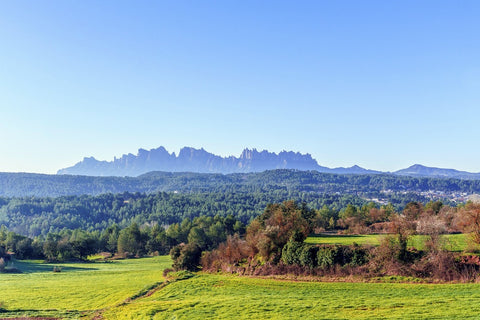Perhaps Spain’s most storied wine region after Rioja, Catalonia (also known as Catalunya in the Catalan language) is an endlessly captivating mosaic of grape varietals, wine styles, and production methods. Catalonia is located in the northeast of Spain and lines the Mediterranean coast from Montsia in the south to the border with France in the north. The politically autonomous home of the Catalan people, Catalonia produces benchmark still and sparkling wines from both well-known areas like Cava and Priorat, as well as quality finds from smaller, lesser-known subregions and emerging vintners.
The Phoenicians and the Greeks likely introduced viticulture around 400 B.C. to Catalonia through trade. The Roman empire expanded grape cultivation, and the industry flourished until Moorish occupation; by the late 18th Century, wine and spirits were some of the most important exports of the region.
With the dynamic metropolis of Barcelona at its rough midpoint, Catalonia includes 11 specific DOs (Denominación de Origen, Spain’s geographic indication label), as well as the more general Catalunya DO, which covers wines produced from outside of those 11 regions. While Priorat and Penedes are best known globally for their wines, lesser-known subregions like Terra Alta and Conca de Barberà are developing quality reputations for specific styles.
Climate and Terroir of Catalonia
Like many of the great European wine regions, Catalonia’s varied geography lends itself to its diverse wine culture. Much of the vineyard area is located south of the iconic Montserrat Massif mountain range near the city of Barcelona, while smaller vineyards dot the area to the north of the city, up until to the mountainous French border in the Pyrenees. Warmer Mediterranean climates with moderate rainfall are found along the coast and inland valleys, with cooler temperatures dominating the mountain plateaus up 2,000 ft (610 m) above sea level.
Catalonia includes a diversity of soil types, largely calcareous sediments mixed with alluvium and clay, while some of the most acclaimed vineyards in the region are found on some of the scattered limestone deposits in the area.
White wines of Catalonia
Parellada, Xarello, and Macabeo are the chief white grapes both in Cava -- the champagne-method sparkling white wine largely produced in the Penedes area of Catalonia -- and in greater Catalonia. All three are thought to be native to Catalonia and deeply intertwined with the identity of Penedes wines. These three grapes are blended to create Cava, and, like in the Champagne region with Pinot Noir, Chardonnay and Pinot Meunier, each of the Cava grapes contributes specific elements like floral aromatics and crisp acidity to the wines. Together, they produce the signature balanced sparkling wines with beautiful aromatics and classic yeasty and bready notes.
In 2019, some Cava producers opted out of the Cava DO to produce under the new label Corpinnat which emphasized high-quality, lower-intervention sparkling wines. In addition, there has been a growth of excellent single-varietal Macabeo and Xarello still wines from low-intervention focused producers.
Red wines of Catalonia
Garnacha, or Grenache, flourishes here as in many other parts of Spain. The iconic Spanish varietal. In particular, both the Priorat and Penedes appellations are well-known for their cultivation of Garnacha and usage in bold, red wines. In the Priorat DOC, intense, old-vine Garnacha-based red blends brought the appellation to worldwide fame and prominence in the 1990s.
Carignan (Samso in Catalan), a classic western Mediterranean varietal, is perhaps best known for its prominence in Southern France and the Rhone valley red blends. The varietal thrives in Catalonia’s warm weather and due to its high tannin, acidity, and color, is often mixed with Garnacha, Syrah, and Mouvedre (Monastrell).
Tempranillo (Ull de Llebre in Catalan) is widely grown. Although overshadowed by its home in the famous Rioja appellation, it thrives in the hot and humid low-lying plains of Catalonia.
Monastrell (Mouvedre or Mataro), traditionally a blending grape and better known in Provence and Southern France, Monastrell produces dark, tannic, and savory single-varietal wines.
Bordeaux varietals, like Merlot and Cabernet, are also found in Catalan red wines and used in some of the higher-end red blends.
Cuisine of Catalonia
Tethered to the classic flavors of the Mediterranean, Catalan cuisine is still quite diverse. Mediterranean staple ingredients like pasta, artichoke, olive oils, and pine nuts are common, but local dishes can vary between the inland and coastal areas of Catalonia. Pork-centric dishes (Braised or Roasted) are found in the former area, while seafood recipes (famously Catalan fish stew) dominate the coastal regions. In combination, meat and seafood elements come together in a sumptuous Catalan rendition of ‘surf and turf,’ known as mar i muntanya; this can include variations like chicken and lobster, or rice and meat.

